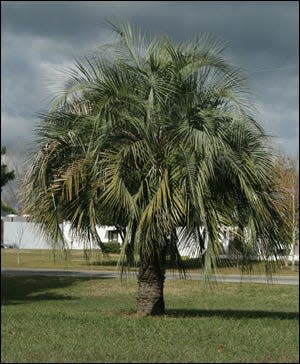Plant diversity makes your Brevard landscape healthier | Sally Scalera
Have you noticed a lot of plants are over-planted throughout the county?
Just look at all the subdivisions with Queen palms planted in every yard and the common areas also. Yet, nature’s way of growing favors diversity, which can provide benefits, especially when compared to a monoculture. With a little careful planning, biodiversity can be created when a new landscape is designed, or increased if the correct plants are chosen to replace those that die.
Some of the insects and diseases that have become established in Florida within the past 10 years include citrus canker, citrus greening, laurel wilt, chili thrips, rugose spiraling whitefly, fusarium wilt of both queen and Mexican fan palms, lethal bronzing (previously called Texas Phoenix palm decline or TPPD), and fusarium wilt of Canary Island date palm.
It’s been estimated that a new pest becomes established in Florida every month.
Many residents have already experienced the devastation of these pests, and because of the high number of susceptible host plants growing throughout the county, more plants could be affected in the future.
To maintain a high level of biodiversity in the landscape, a good rule of thumb is the 5-10-15%. When following this rule, a maximum of 5% of the plants chosen for a park, commercial planting, subdivision or a yard, should be the same genus and species (ex. Magnolia grandiflora). The second part of the rule is that no more than 10% of the plants chosen are in the same genus (ex. Magnolia) and finally, no more than 15% of the plants are in the same plant family.
An example that highlights the importance of the 15% plant family rule is laurel wilt. This disease is spread by an ambrosia beetle that is attracted to our native redbay trees when they are stressed or not as healthy as they should be. The sad news is, the same ambrosia beetle is also attracted to stressed avocado trees, which are in the same plant family, Lauraceae. Following the 5-10-15% rule can protect a landscape from losing a high percentage of plant material to an outbreak of an invasive pest.
Before planting a new queen palm, keep in mind that we have fusarium in the county that can kill a queen palm quickly once it becomes infected. There are a few palms that are underutilized so, keep these palms in mind if you lose a palm in your landscape. Though, if you already have a lot of palms, you will be better off replacing them with a tree instead. That’s because you want to aim for no more than 15% of the plants in your yard from the same plant family, and all palms are members of the Arecaceae plant family.
If you don’t already have a lot of palms and you lose a Queen palm, Mexican fan palm, Canary Island date palm or any other species of date palms (Phoenix spp.), consider one of the following palms as a possible replacement:

The pindo palm (or jelly palm), Butia capitata, has blue-grey feather-shaped fronds. It is also very cold hardy and will produce edible fruit that can be made into jam or jelly. This palm is slow-growing and salt tolerant, can reach a height of 20-25 feet, and is an attractive specimen plant. Unlike Washingtonia palms, which get so tall that they just become trunks in the landscape, the pindo palm remains small.
There is also the Mule palm, X Butyargrus nabonnandii, which is a cross between the queen and pindo palms. The common name, mule, comes from the fact that the palm is sterile, so you won’t need to worry about palm seedlings sprouting up everywhere. The resulting cross combines good traits from both parents. The mule palm is fast growing to 30 feet, can handle full sun or partial shade, is both salt and drought-tolerant, and is cold hardy. The mule palm is also resistant to lethal bronzing.
Another uncommon palm to consider would be the Taiwan dwarf sugar palm, Arenga engleri. This clumping palm has feather-shaped fronds and a slender trunk. It typically grows to just 10 feet and is slow growing. Allow plenty of room for this palm to spread, and after fruiting, the trunk can be cut down because it will die after it produces fruit. The flowers, which are very fragrant, can be cut off after they fade (and the bees were able to gather nectar and pollen) to prevent fruit from being produced. If the fruit is produced, wear rubber gloves when handling it, because it contains high concentrations of skin-irritating chemicals.
If you don’t have big plans for the weekend, go take an inventory of your plants to see how much diversity there is in your landscape. If you have a lot of palms, you may already be over the 15% threshold for the plant family limit. If you find that your landscape’s biodiversity is low, add some different plants to your landscape if any plants die in the future.
Sally Scalera is an urban horticulture agent and master gardener coordinator for the University of Florida’s Institute of Food and Agriculture Sciences. Email her at sasc@ufl.edu.
This article originally appeared on Florida Today: Over-planting palms can wreak havoc on your Florida landscape
